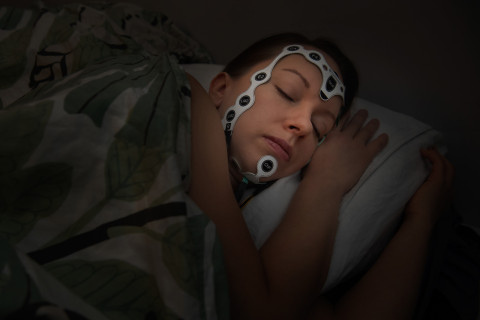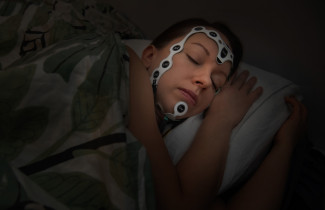Obstructive sleep apnoea (OSA) is a highly common sleep disorder where the upper respiratory tract repeatedly narrows during sleep causing complete (apnoea) or partial (hypopnoea) breathing obstructions. In people with OSA, breathing obstructions often decrease their blood oxygen saturation temporarily and break their normal sleep structure by causing several arousals from sleep during the night. In Finland alone, obstructive sleep apnoea has major consequences for public health and the economy, since it has been estimated that up to one third of Finns suffer from OSA.
The severity of OSA is determined with polysomnography. Polysomnography recordings can be used to assess, e.g., the structure of sleep and arousals, the prevalence, type, and duration of respiratory events, as well as the resulting drops in blood oxygen saturation. Although all of these can be determined from polysomnography, the diagnosis of OSA is mainly based on the average number of apnoea and hypopnoea events per hour of sleep. However, polysomnography recordings contain a great deal of information that could be used in the diagnostics of OSA much more extensively than today.
In addition, sleep stages and physiological events during sleep, such as stops in breathing, drops in blood oxygen saturation, and arousals from sleep currently need to be determined manually from polysomnography, which is time-consuming and therefore expensive. However, the determination of these events from biosignals would be done with modern methods employing neural networks and machine learning. By using such methods, it would be possible to analyse polysomnography recordings considerably faster and more cost-effectively than at present.
Solutions to shortcomings in the diagnosis of OSA are being sought by the Sleep Technology and Analytics Research (STAR) group at the University of Eastern Finland by, for example, examining the clinical picture of OSA more closely and by using the obtained information to develop increasingly accurate diagnostic parameters. The group is also developing methods that utilise artificial intelligence and deep learning for reliable and cost-effective automated analysis of polysomnography recordings.
In a study led by Henna Pitkänen, MSc, (Pitkänen et al., IEEE Trans Biomed Eng, 2021) researchers examined whether arousals from sleep due to various respiratory events appear in the overnight electroencephalogram (EEG) in different manners. The study focused especially on the higher frequencies of the EEG signal, i.e., the gamma frequency band (30–40 Hz). The gamma power in the EEG signal was studied during arousals caused by respiratory events between different sleep stages and different respiratory events. It was found that the deeper the sleep stage, the higher the gamma power during the arousal. In addition, gamma power was higher in events following obstructive apnoeas than hypopnoeas, as well as when obstructive apnoeas related to arousals were longer in duration. As increased power in the high-frequency gamma band of the EEG may indicate a stronger shift from sleep to awake, the results illustrate that the degree of sleep disturbance may vary depending on the type and duration of the respiratory event.
In a study led by Riku Huttunen, MSc (Tech), (Huttunen et al., Sleep, 2021), researchers assessed sleep fragmentation from the photoplethysmography (PPG) signal by using automated sleep stage classification that is based on deep learning. Sleep fragmentation was assessed for individual patients based on the average length of a continuous sleep period. A deep learning model was used to identify sleep stages with a denser time resolution than the one used in manual classification performed by a sleep technician (30 s), and different resolutions (30 s, 15 s, 5 s) were compared between sleep apnoea severity categories. Automated classification at different resolutions was also compared with manual sleep stage classification. In all cases, the risk of reduced continuous sleep increased as the severity of OSA increased, but the differences between severity categories were greater with denser time resolution. Based on the results, a denser time resolution in the automated sleep stage classification from the PPG signal clearly highlights individual differences in sleep fragmentation.
In a study led by Sami Nikkonen, PhD, (Nikkonen et al., IEEE J Biomed Heal Informatics, 2021), researchers developed a machine learning method to enable automated identification of respiratory events from polysomnography recordings. In the identification of respiratory events, the method reached an 89% correspondence to manual analysis, and the average difference in the number of respiratory events identified compared to manual analysis was 3.0 respiratory events per hour. These correspondences are similar to the variability of manual analysis performed by different clinical experts. The method developed could therefore be used for reliable automated identification of respiratory events. As the method also identifies the beginning and end of respiratory events, it is also possible to visually check the automated analysis. In addition, the method could enable the diagnosis of OSA based on data from several nights, without increasing the time or resources required for analysis. Nightly variation in the number of respiratory events and the resulting uncertainty in the assessment of the severity of OSA could thus be minimised.
In a collaborative study led by Arie Oksenberg, PhD, (Oksenberg et al., J Sleep Res, 2021), researchers investigated differences between non-sleepy, sleepy, and very sleepy patients with mild sleep apnoea. The study utilised patients' medical records, clinical sleep studies, and information on sleep habits. The study did not find any significant differences in the clinical parameters calculated based on sleep studies between the different sleepiness categories. Only the number of arousals from sleep was significantly higher in sleepy patients compared to non-sleepy ones. Although expectedly, very sleepy patients reported to sleep much less in the week than non-sleepy patients, and perhaps for that reason they felt very tired. Based on the study, severe daytime sleepiness is not explained by the number or severity of duration events in patients with mild sleep apnoea. The greatest factor contributing to sleepiness appears to be poor sleep habits (such as insufficient sleep on workdays) and poor sleep quality.
For further information, please contact:
Associate Professor Timo Leppänen, PhD, timo.leppanen [at] uef.fi
Postdoctoral Researcher Sami Nikkonen, PhD, sami.nikkonen [at] uef.fi
Early Stage Researcher Henna Pitkänen, MSc, henna.pitkanen [at] uef.fi
Early Stage Researcher Riku Huttunen, MSc (Tech), riku.huttunen [at] uef.fi
Sleep Technology and Analytics Research (STAR) group
Publications:
Pitkänen H, Duce B, Leppänen T, Kainulainen S, Kulkas A, Myllymaa S, Töyräs J, and Korkalainen H. Gamma Power of Electroencephalography Arousal is Modulated by Respiratory Event Type and Severity in Obstructive Sleep Apnea, IEEE Transactions on Biomedical Engineering, https://doi.org/10.1109/TBME.2021.3118229, online print October 6, 2021. Epub ahead of print.
Huttunen R, Leppänen T, Duce B, Oksenberg A, Myllymaa S, Töyräs J, and Korkalainen H. Assessment of obstructive sleep apnea-related sleep fragmentation utilizing deep learning-based sleep staging from photoplethysmography, Sleep, Volume 44, Issue 10, October 2021 (Published online 05 June 2021), https://doi.org/10.1093/sleep/zsab142
Nikkonen S, Korkalainen H, Leino A, Myllymaa S, Duce B, Leppänen T, and Töyräs J. Automatic Respiratory Event Scoring in Obstructive Sleep Apnea Using a Long Short-Term Memory Neural Network. IEEE Journal of Biomedical and Health Informatics, 2021, 25(8), 2917–2927. https://doi.org/10.1109/JBHI.2021.3064694
Oksenberg A, Goizman V, Eitan E, Nasser K, Gadoth N, and Leppänen T. How sleepy patients differ from non-sleepy patients in mild obstructive sleep apnea? Journal of Sleep Research, 2021, e13431, https://doi.org/10.1111/jsr.13431, online print July 29, 2021. Epub ahead of print.






